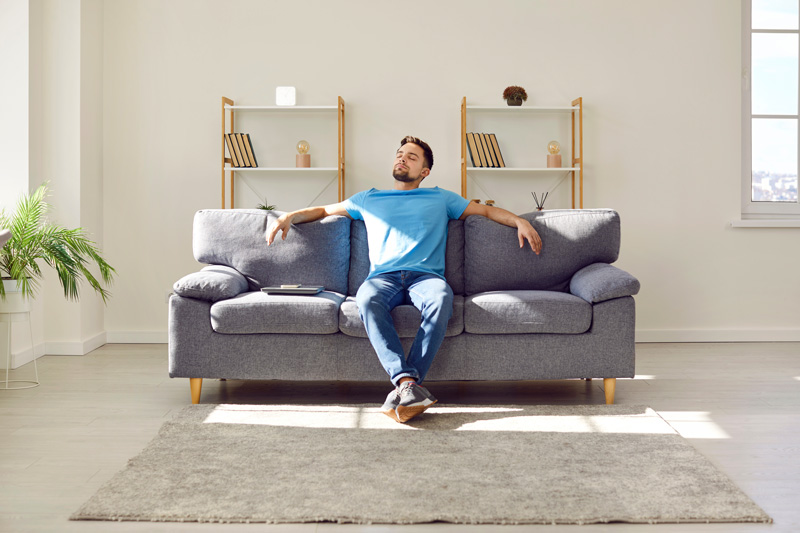Home should be a place where you can relax, feel safe, unwind from the day, and feel like it is your space. However, not everyone has that option. To illustrate, in our work of supporting inclusive housing for autistic adults for over 16 years at Madison House Autism Foundation, we have found that housing is the most significant national concern, especially because most housing options lack autism-friendly and sensory-friendly features. As a result, autistic adults often face barriers to home environments that fit their needs. If autistic adults and family members happen to find housing that fits those needs, they often face additional roadblocks, such as high costs, disconnected services, multi-year waitlists, support service workforce shortages, and more (Kameka Galloway & Martinez, 2023). Accordingly, with an estimated 5.4 million and growing adults on the autism spectrum in the U.S. (Dietz et al., 2020), more low-barrier, inclusive housing that accommodates sensory and other needs is imperative. Therefore, increasing the quantity of sensory-friendly housing stock, or even creating your own sensory-friendly home, can help to reduce some of these barriers.

What Does Sensory-Friendly Mean?
One common challenge for autistic adults is their sensitivity to different sensory experiences. For example, some are sensitive to sensory inputs, such as sounds, smells, fabrics, light, and more. On the other hand, some have low sensitivity to these experiences and seek ways to boost that input. Still, others may have a combination of low and high sensitivity. You might have someone who seeks out soft textures to feel calmer but still gets overwhelmed with multiple strong inputs, such as loud noises and bright lights (Elwin et al., 2016; Morgan, 2019). Looking at neuroimaging with autistic individuals, researchers found that there is evidence of hyperreactivity in some autistic individuals’ brains when presented with sensory stimulation. This hyperreactivity is in combination with the brain staying reactive longer. The parts of the brain that help regulate emotions and return to their normal baseline state are slower to make that process happen than in neurotypical populations and those without high sensory sensitivity (Green et al., 2015). Sensory-friendly design keeps these sensory sensitivity challenges in mind and accounts for them, whether through less stimulating features or spaces that offer more user control over sensory input, such as lighting, noise, colors, fabrics, etc. This accommodation can be an essential tool for preventing anxiety and depression (Morgan, 2019).
The Current Housing Market
Very few data sets exist that track housing characteristics that meet the needs of autistic adults and others with intellectual and/or developmental disabilities (I/DD; Resnik & Kameka Galloway, 2020). And so, the growing need for data and inclusive housing sparked a recent chain of I/DD-focused housing market analyses in cities across the U.S. (First Place AZ, 2023); however, more research is needed. Despite this scarcity of data, one can start seeing more diverse housing options trying to meet the critical and rising demand with the small amount of current research and directories. “However, publicly funded programs do not come close to fully meeting the high volume of unmet housing needs among adults with autism and/or I/DD,” shares researchers from a groundbreaking 2020 report on housing and community options for neurodivergent adults (Resnik & Kameka Galloway, p. 189). “Existing federal and state programs also do not adequately support the development of residential options to accommodate the diversity of needs and preferences within this population” (Resnik & Kameka Galloway, p. 189). Many autistic adults and others with I/DD are at high risk of homelessness or sudden displacement due to inaccessible, non-inclusive housing and aging caregivers (Resnik & Kameka Galloway, 2020).
What You Can Do
If you want to create a sensory-friendly housing community or modify your home, here are some tips for getting started.
Consider Different Physical Amenities
Sensory-friendly housing design involves finding ways to keep noise levels low and visual design simple and relaxing. For example, extra soundproofing, quiet appliances and soft-close cabinetry, muted-color flooring and walls, and soft lighting. Softer textures throughout the design can also be supportive. Built-in relaxation options can also boost sensory serenity, such as incorporating small nooks or rooms for quiet spaces or adding reinforced beams for hammocks and swings. In addition, smart-home amenities can automatically set lighting and other features as you want them as the environment changes. For example, automatic lights and blinds can create accessible sensory safety as daylight changes (Resnik & Kameka Galloway, 2020).
Ideas for Larger Housing Communities
Housing communities with extra space on the property may be able to have extra amenities that smaller homes and apartments cannot. For example, properties with walking paths in quiet nature can be an excellent option in rural areas or areas where it is possible to block out most of the noise from the city. Larger sensory rooms are also an option on community properties. Sensory rooms can incorporate dimmable lighting, extra soundproofing, soft pillows and textures, beanbags, slow-motion art, soundscape and music options, and more (Resnik & Kameka Galloway, 2020). On-site pools can also be a calming sensory experience (Lawson et al., 2019; Musiyenko et al., 2020), especially if there is a reservation option to have quiet time in the pool without others around.
Other Tips to Keep in Mind
When designing for autistic adults, it is important to remember that each individual has unique challenges, abilities, and preferences. What works for one may not work for another. However, the more accessibility options you provide, the more inclusive you can make your project or housing community. A helpful first step is to look at some existing, successful models of sensory-friendly housing across the U.S. (Autism Housing Network, 2023). However, no matter your project, consult with autistic individuals to get their feedback or use information that reflects the voices of autistic adults because they have lived experience that provides the best source of information.
There is a great quote in the disability community: Nothing about us, without us. The autistic community doesn’t always have a voice, and it’s not just because some of us are non-verbal” (Birch, 2021). In conclusion, thoughtfully constructing sensory-friendly housing and listening to the voices of autistic adults helps to make it feel like it is their space, their place in the world.
More information about the Autism Housing Network or its parent organization, Madison House Autism Foundation, can be found at autismhousingnetwork.org. Questions and feedback can be sent to Ann Carrick, MA, Communications Manager at Madison House Autism Foundation at ahn@madisonhouseautism.org.
References
Autism Housing Network. (2023). Getting started with creating housing. Madison House Autism Foundation. https://www.autismhousingnetwork.org/learn/blog/getting-started-with-creating-housing/
Birch, N. (2021, March 30). Nothing about us, without us: Playing a part in the neurodiversity revolution. Milestones Autism Resources. https://www.milestones.org/resources/blog/2021/03/30/nothing-about-us-without-us-playing-a-part-in-the-neurodiversity-revolution
Dietz, P. M., Rose, C. E., McArthur, D., & Maenner, M. (2020). National and state estimates of adults with autism spectrum disorder. Journal of autism and developmental disorders, 50(12), 4258-4266.
Elwin, M., Schröder, A., Ek, L., Wallsten, T., & Kjellin, L. (2017). Sensory clusters of adults with and without autism spectrum conditions. Journal of autism and developmental disorders, 47, 579-589.
First Place AZ. (2023). Housing market analyses: Driving future planning, funding and advancement in public policy. https://www.firstplaceaz.org/leadership-institute/housing-market-analyses/
Green, S. A., Hernandez, L., Tottenham, N., Krasileva, K., Bookheimer, S. Y., & Dapretto, M. (2015). Neurobiology of sensory over-responsivity in youth with autism spectrum disorders. JAMA psychiatry, 72(8), 778-786.
Kameka Galloway, D., Martinez, S. (2023). Salt Lake Valley neuro-inclusive housing market analysis: Data driving a place in the world for autistic adults and others with intellectual/developmental disabilities. Madison House Autism Foundation. www.neuroinclusiveutah.org/findings
Mische Lawson, L., D’Adamo, J., Campbell, K., Hermreck, B., Holz, S., Moxley, J., Nance, K., Nolla, M., & Travis, A. (2019). A qualitative investigation of swimming experiences of children with autism spectrum disorders and their families. Clinical Medicine Insights: Pediatrics, 13, 1179556519872214.
Morgan, H. (2019). Connections between sensory sensitivities in autism: The importance of sensory friendly environments for accessibility and increased quality of life for the neurodivergent autistic minority. PSU McNair Scholars Online Journal, 13(1), 11.
Musiyenko, O. V., Chopyk, R. V., & Kizlo, N. B. (2020). Influence of swimming on sensory functioning, quality of life and behavior of children with autism. Health, sport, rehabilitation, 6(3), 60-69.
Resnik, D. D., & Kameka Galloway, D. (Eds.). (2020). A place in the world: Fueling housing and community options for adults with autism and other neurodiversities. Phoenix, AZ: First Place AZ; Madison House Autism Foundation; the Arizona Board of Regents for and on behalf of Arizona State University and its Morrison Institute for Public Policy at the Watts College of Public Service and Community Solutions.





